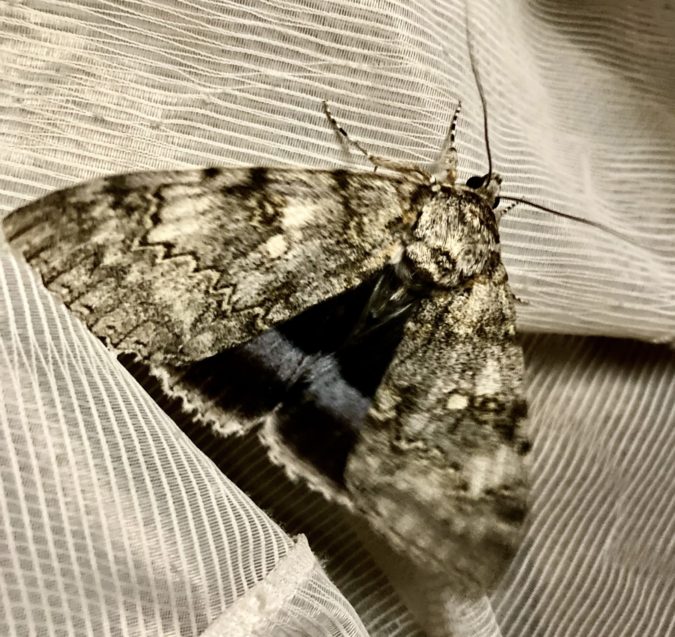A very special visitor.

The first few weeks of owning a patch of woodland feel like the beginning of a long and special relationship. Every discovery is new; each adventure a first. A wood reveals it secrets slowly. We’ve already tramped round every corner of the wood, tearing our shins on brambles, sniffing at fungi, clambering round stumps and totting up the oak, hazel, maple, cherry and rowan that thrive under our canopy of pine and larch. We’ve sat and looked and listened in all weathers, at every time of day.
Starting a list of birds was the first thing to do: a mewing buzzard overhead, marsh tits pitching in the roving tit flock, the tap of woodpecker and nuthatch. Autumn – though this year so mild and late – soon announced itself with a first skein of pink-footed geese calling high and unseen over the wood, the first redwing chattering at the wood edge… sounds and colours change; the big wheel keeps on turning…
We have always loved moths, for their beauty, their ubiquity, their astonishing variety. Moths range in size from the tiny micros whose larvae leave scribbled signatures across the leaves in which they live, to the powerful hawkmoths or that mythic blue-underwinged beauty the Clifden Nonpareil, a creature practically the size of a small bat, and probably the most sought-after moth among the old collectors with, in some years, just a single individual found across the country. For there’s also a rich and often eccentric history of moth recording in this country with most of the larger moths – the macros - having evocative vernacular names (though don’t confuse your Bright-line Brown-eye with a Brown-line Bright-eye!), and an array of techniques for acquiring them from pupa digging, plastering tree trunks with mixtures of treacle and rum, to light. Nowadays, moths are generally photographed and released rather than pinned; recording them is an excellent way of assessing the biodiversity of a site or tracking population changes.
It was clearly time to break out the old moth trap. And so it was that this September for the first time in years we dusted down the generator, filled the trap with fresh egg boxes for the anticipated moths to settle on, spread out our white sheet in a promising looking glade, and hoped to goodness that our 125W mercury vapour bulb would still fire up after all these years… As night came the light shed unfamiliar shadows through the wood; we waited, net in hand, taking care not to look directly at the blazing UV light; waited with a palpable sense of anticipation… what secret would the wood reveal?
At first, nothing. And then a first furtive fluttering across the clearing to the trap – probably a Common Marbled Carpet though I’d have to check – and a plumper-bodied moth, and me there wracking my brains: it’s a noctuid, sure, but I’m so rusty – what’s-it-called? Flame? Flame Shoulder? Setaceous Hebrew Character…?
‘What the hell was that?’ said Beth
Something ridiculously large had flapped out of the shadows and vanished. Knelt at the trap, I’d glimpsed it too from the corner of my eye. Could it be a hawkmoth on our very first trap, that would be very cool! I grabbed the net; we stood back and waited.
I knew we had something beyond the ordinary when Beth yelled ‘There it is!’ and I swung the net and captured it on a second sweep. It was big all right! Anxious not to lose our catch, whatever it was, we shut ourselves in the toolshed and peered into the gently-opening net with our torch…
The moth was the shape of a vulcan, practically size of a small bat, and more beautiful than anyone can do justice to: a marbled, lichenous beauty, zig-zagged and pocked and dabbed with greys and whites and blacks and – look! – when those forewings flick open an underwing black and banded with an impossible flash of blue…
‘It’s a Blue Underwing,’ we cried, ‘A Clifden Nonpareil…!’

An entry in my Aurelian’s Fireside Companion describes the experience soberly: ‘For a moment or two we gazed at it in speechless admiration, fearing almost to breathe lest it take flight…’. I suspect we used a few more expletives than that! And what a secret to reveal; our first trap in the new wood and we caught probably the best moth we could ever hope to find. One truly without compare. Soon after the generator packed in; we were plunged into darkness.
2022, it transpires, has been a record year for Clifden Nonpareils, as it has been for many rare moths. Our Nonpareil could have been a wanderer from further south in England where a population has now reestablished itself on aspen and poplar after decades of extinction – or (and I find this the more romantic possibility) it could have been a migrant from the east, flapping its way across the North Sea to our northerly inland wood, and revealing itself, albeit briefly, to its astonished and delighted admirers…
By torchlight, we placed the moth on a tree stump, astounded to see something we’d always dreamt of finding. It sat there for a moment, as though contemplative, then showed a flash of blue petticoat as it shivered its huge and brindled grey wings. Shivered again. And flew off into the night.
What will the seasons bring?
Comments are closed for this post.
Discussion
Great post Paul. I’m a enthusiast on Clifdens and I recently went to Ty Isaf Woods as we had a job for https://www.waleswoodland.co.uk and found a few there. I believe they actually like damp woods and usually find them nesting on lower grounds.

Lovely, inspiring, what a treat…
Michelle
13 November, 2022